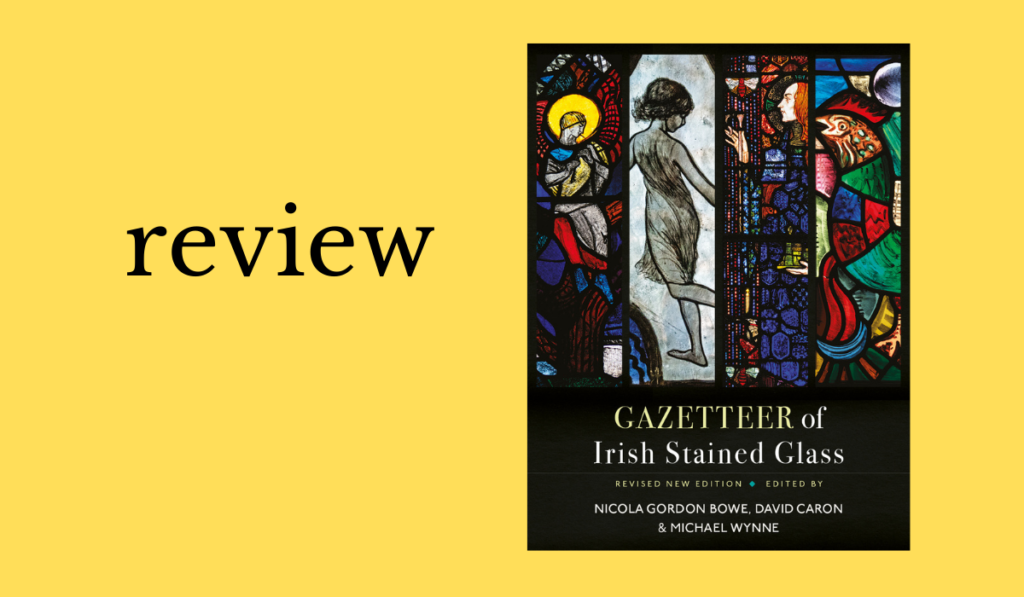
Gazetteer of Irish Stained Glass: Revised New Edition|Irish Academic Press|ISBN
9781788551298
Isolde Goggin reviews the magnificently illustrated and elaborately produced book on Irish stained glass
Stained glass is, I think, undervalued as an art form. Much attention is given to, and high prices paid for, more portable forms of art such as painting and sculpture. Perhaps because a stained glass window is firmly placed in situ, it does not lend itself to being collected.
Nevertheless, I would contend that by whatever measure, the stained glass artist is just as skilled and creative as their counterpart in other fields of art. Moreover in Ireland we have one of the outstanding masters of stained glass in Harry Clarke, who receives special recognition in this book. In his short life he produced both ecclesiastical and secular stained glass windows that are recognised internationally as great works of art.
Magnificent illustrations
This book is a follow-up to the first edition of thirty years ago. It is a more elaborate production with many more illustrations and a longer list of stained glass windows.
It builds on the work of the original trio of David Caron, the late Michael Wynne and the late Nicola Gordon Bowe, meaning that there is in total thirteen people involved, including photographer, Jozef Vrtiel whom we have to thank for the magnificent illustrations.
This is an excellent production, well laid out and easy to follow. While the actual gazetteer takes up most of the book, there is also an introduction to the history of Irish stained glass, an overview of the current state of the art, a list of all the artists involved and then a separate section of biographical notes on selected artists. In other words, this is a comprehensive publication which covers all aspects of the subject.

Breadth of localities
Stained glass is usually associated with ecclesiastical buildings and that is true of most of the examples listed here. However stained glass windows can be found in a variety of locations across the country including art galleries, hotels, restaurants and even pubs. In some cases this is because an ecclesiastical building such as a convent has been converted for another use but in other cases, the windows were specifically commissioned.
The breadth of localities across every county is evidence of how strong stained glass production was in Ireland and how much it continues to be important.
However, one surprising aspect revealed in the gazetteer is the international dimension of Irish stained glass artists, with their work being commissioned in a number of countries such as England, America, South Africa and Singapore among others. I am glad to say that Harry Clarke’s Geneva Window, now in the Wolfsonian-Florida International University in Miami, gets due mention too.
Development of stained glass
A theme that emerges is the progress or development of stained glass art in Ireland. We can see how the style, subject matter, use of colours, etc. have changed in the last one hundred years.
The work of Harry Clarke and his contemporaries, such as Evie Hone, tends to be more intricate, dense and richly coloured than the work of more recent artists which tends to be simpler in design and sparer in its use of colour. The subject matter too has changed as saints and biblical scenes are now joined by abstract design and memorials to secular figures such as patrons of a pub.
Updated lists
While the book is bigger than pocket-sized, I will certainly bring it with me the next time I do a tour of stained glass. It will be a great aid in planning a trip as it not only tells me where to find the various windows but also the number of examples in each location. For while many buildings, such as churches, may have dozens of stained glass windows, others may have just one or two.
The Irish Academic Press is to be commended for producing this gazetteer. In the thirty years since the first edition, many new stained glass windows have been commissioned so it’s good to have an updated list of those too.
I do have one personal issue to raise and that is the absence from the gazetteer of two fine examples of Harry Clarke’s work in St. James’s Catholic Church, Grange, Co. Louth. These were not mentioned in the first edition either but I expected that they would have been included in this one. It would appear that the windows are not appreciated by the current parishioners as they are obscured by statues placed in front of them. Inclusion in the gazetteer may have persuaded the church to reconsider the windows’ artistic merit.












